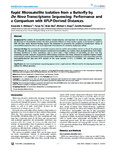Rapid microsatellite isolation from a butterfly by de novo transcriptome sequencing: performance and a comparison with AFLP-derived distances.
| dc.contributor.author | Mikheyev, AS | en |
| dc.contributor.author | Vo, T | en |
| dc.contributor.author | Wee, B | en |
| dc.contributor.author | Singer, MC | en |
| dc.contributor.author | Parmesan, C | en |
| dc.date.accessioned | 2017-05-22T15:21:23Z | |
| dc.date.available | 2017-05-22T15:21:23Z | |
| dc.date.issued | 2010-06-18 | en |
| dc.identifier.uri | http://hdl.handle.net/10026.1/9303 | |
| dc.description.abstract |
BACKGROUND: The isolation of microsatellite markers remains laborious and expensive. For some taxa, such as Lepidoptera, development of microsatellite markers has been particularly difficult, as many markers appear to be located in repetitive DNA and have nearly identical flanking regions. We attempted to circumvent this problem by bioinformatic mining of microsatellite sequences from a de novo-sequenced transcriptome of a butterfly (Euphydryas editha). PRINCIPAL FINDINGS: By searching the assembled sequence data for perfect microsatellite repeats we found 10 polymorphic loci. Although, like many expressed sequence tag-derived microsatellites, our markers show strong deviations from Hardy-Weinberg equilibrium in many populations, and, in some cases, a high incidence of null alleles, we show that they nonetheless provide measures of population differentiation consistent with those obtained by amplified fragment length polymorphism analysis. Estimates of pairwise population differentiation between 23 populations were concordant between microsatellite-derived data and AFLP analysis of the same samples (r = 0.71, p<0.00001, 425 individuals from 23 populations). SIGNIFICANCE: De novo transcriptional sequencing appears to be a rapid and cost-effective tool for developing microsatellite markers for difficult genomes. | en |
| dc.format.extent | e11212 - ? | en |
| dc.language | eng | en |
| dc.language.iso | eng | en |
| dc.subject | Animals | en |
| dc.subject | Base Sequence | en |
| dc.subject | Butterflies | en |
| dc.subject | DNA Primers | en |
| dc.subject | Gene Expression Profiling | en |
| dc.subject | Genetic Markers | en |
| dc.subject | Microsatellite Repeats | en |
| dc.subject | Polymorphism, Genetic | en |
| dc.title | Rapid microsatellite isolation from a butterfly by de novo transcriptome sequencing: performance and a comparison with AFLP-derived distances. | en |
| dc.type | Journal Article | |
| plymouth.author-url | https://www.ncbi.nlm.nih.gov/pubmed/20585453 | en |
| plymouth.issue | 6 | en |
| plymouth.volume | 5 | en |
| plymouth.publication-status | Published online | en |
| plymouth.journal | PLoS One | en |
| dc.identifier.doi | 10.1371/journal.pone.0011212 | en |
| plymouth.organisational-group | /Plymouth | |
| plymouth.organisational-group | /Plymouth/Faculty of Science and Engineering | |
| plymouth.organisational-group | /Plymouth/REF 2021 Researchers by UoA | |
| plymouth.organisational-group | /Plymouth/REF 2021 Researchers by UoA/UoA07 Earth Systems and Environmental Sciences | |
| dc.publisher.place | United States | en |
| dcterms.dateAccepted | 2010-04-26 | en |
| dc.identifier.eissn | 1932-6203 | en |
| dc.rights.embargoperiod | No embargo | en |
| rioxxterms.versionofrecord | 10.1371/journal.pone.0011212 | en |
| rioxxterms.licenseref.uri | http://www.rioxx.net/licenses/all-rights-reserved | en |
| rioxxterms.licenseref.startdate | 2010-06-18 | en |
| rioxxterms.type | Journal Article/Review | en |


